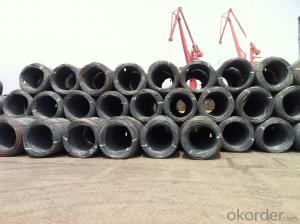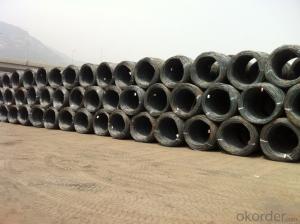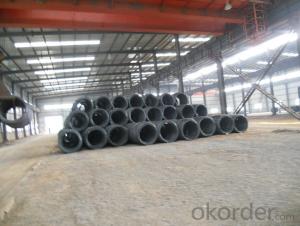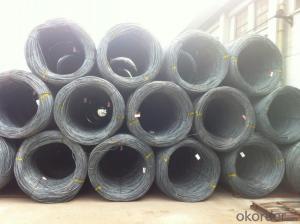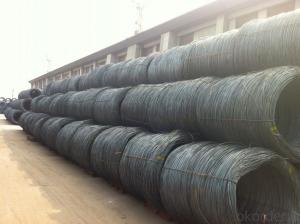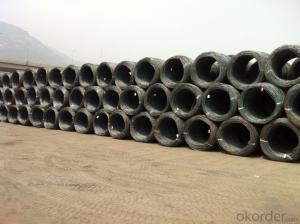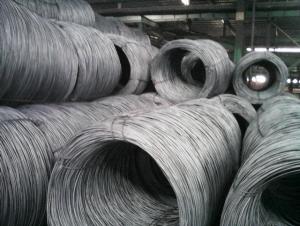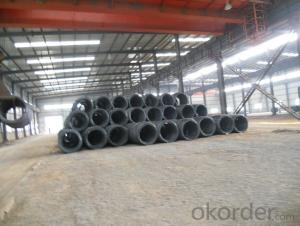Hot Rolled Steel Wire rods with Material Grade SAE1008
- Loading Port:
- Tianjin
- Payment Terms:
- TT OR LC
- Min Order Qty:
- 25 m.t
- Supply Capability:
- 50000 m.t/month
OKorder Service Pledge
OKorder Financial Service
You Might Also Like
OKorder is offering Carbon Steel Wire Rod at great prices with worldwide shipping. Our supplier is a world-class manufacturer of steel, with our products utilized the world over. OKorder annually supplies products to European, North American and Asian markets. We provide quotations within 24 hours of receiving an inquiry and guarantee competitive prices.
Product Applications:
Carbon Steel Wire Rod are ideal for structural applications and are widely used in the construction of buildings and bridges, and the manufacturing, petrochemical, and transportation industries.After hot-rolled the products shaped into coil and delivery as finished product, including round, square, rectangular, hexagonal and so on. Since most of the products are round, it is generally called wire rod. Carbon steel wire rod is widely used in construction and manufacturing. Carbon steel wire rod is mainly used for reinforcement of reinforced concrete and welded structure or reprocessed (roberts , nail, etc.) materials, especially used to produce wire drawing, welding electrode, nails, spring, electronic, precise machinery parts and so on.
Product Advantages:
OKorder's Carbon Steel Wire Rod are durable, strong, and resist corrosion.
Main Product Features:
· Premium quality
· Prompt delivery & seaworthy packing (30 days after receiving deposit)
· Corrosion resistance
· Can be recycled and reused
· Mill test certification
· Professional Service
· Competitive pricing
Product Specifications:
Chemical Composition:
Please kindly find our chemistry of our material based on SAE1006/SAE1008 as below for your information
Grade | Chemical Composition (%) | |||||
C | Mn | S | P | Si | B | |
SAE1006 | 0.03~O.07 | 0.32max | 0.045max | 0.040max | 0.30max | 0.0008min |
Mechanical properties | ||||||
Yield strength(N/mm2) | Tensile strength(N/mm2) | Elongation (%) | ||||
250-280 | 350-380 | ≥32 | ||||
Grade | Chemical Composition (%) | |||||
C | Mn | S | P | Si | B | |
SAE1008 | 0.10max | 0.3~0.50 | 0.050max | 0.040 max | 0.15max | 0.0008 min |
Mechanical properties | ||||||
Yield strength(N/mm2) | Tensile strength(N/mm2) | Elongation (%) | ||||
≥195 | 315-430 | ≥30 | ||||
FAQ:
Q1: How do you guarantee the quality of our products?
A1: We have established an advanced quality management system which conducts strict quality tests at every step, from raw materials to the final product. At the same time, we provide extensive follow-up service assurances as required.
Q2: What's your shipment type ?
A2: Usually we ship the goods by bulk vessel,if you want load them by container vessels,we can arrange as well .
Q3: How soon we can delivery the goods ?
A3: We have a mill with 20000mts of capacity per month. We can delivery the goods within one month.
Image:
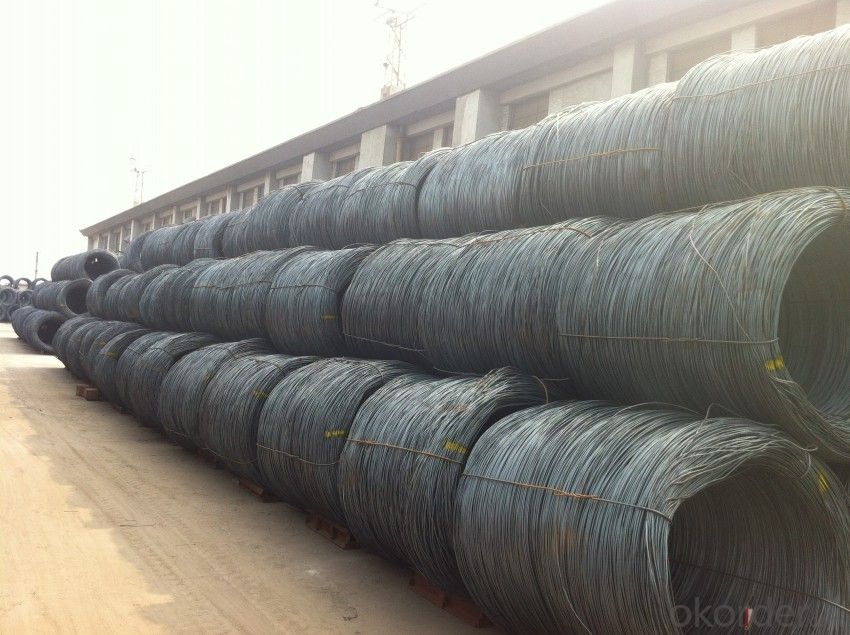
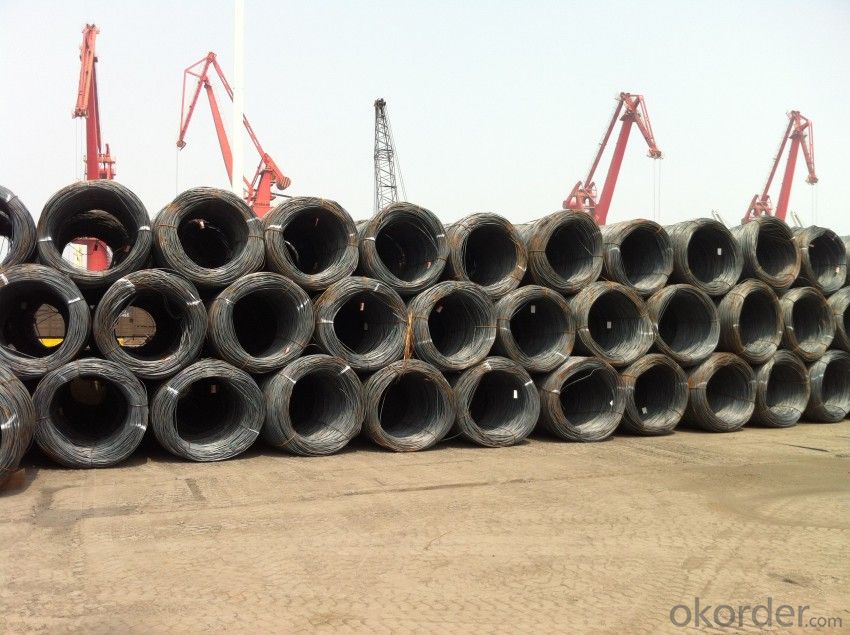
- Q: How is steel wire rod tested for ultimate tensile strength?
- Steel wire rod is typically tested for ultimate tensile strength using a universal testing machine. This machine applies a steadily increasing force to the rod until it fractures. The force required to break the rod is measured, and this value represents the ultimate tensile strength of the steel wire rod.
- Q: What are the different types of steel wire rod surface defect repair methods?
- There are several different types of steel wire rod surface defect repair methods, including grinding, polishing, coating, and heat treatment. Each method is used to address specific types of surface defects, such as scratches, pits, or corrosion. Grinding involves removing the surface layer of the rod to eliminate defects, while polishing smoothens the surface and enhances its appearance. Coating methods, such as electroplating or galvanizing, are used to provide a protective layer against future defects. Heat treatment methods, such as annealing or quenching, can be employed to improve the strength and durability of the wire rod surface. Overall, the choice of repair method depends on the type and severity of the surface defect, as well as the intended application of the steel wire rod.
- Q: How is steel wire rod manufactured?
- Steel wire rod is manufactured through a process called hot rolling, which involves passing a billet or a slab of steel through a series of rolling mills. These mills compress and shape the steel into a long, continuous rod with a specific diameter. The rod is then cooled and coiled, ready to be used in various applications such as construction, automotive, and manufacturing industries.
- Q: How is steel wire rod stored to prevent corrosion?
- Steel wire rods are typically stored in a way that minimizes the risk of corrosion. One common method is to store the rods in a well-ventilated area with controlled humidity levels. This helps to prevent the build-up of moisture, which can accelerate the corrosion process. Another preventive measure is to store the steel wire rods in a dry environment and off the ground. This can be achieved by placing the rods on pallets or racks, ensuring that they are not in direct contact with the floor. By keeping the rods elevated, any potential moisture or water accumulation on the ground is avoided. Furthermore, steel wire rods can be stored indoors in a climate-controlled warehouse. Maintaining a stable temperature and humidity level can significantly reduce the chances of corrosion. These controlled environments help to minimize moisture exposure and prevent the formation of rust on the wire rods. In addition to these storage practices, coating the steel wire rods with a protective layer is also a common preventive measure. This can be done by applying a corrosion-resistant coating such as zinc or epoxy. The coating acts as a barrier between the rods and the surrounding environment, preventing moisture from reaching the surface of the wire rods and causing corrosion. Overall, proper storage of steel wire rods involves minimizing moisture exposure, maintaining controlled humidity levels, keeping the rods off the ground, and using protective coatings. By implementing these measures, the risk of corrosion is significantly reduced, ensuring that the steel wire rods remain in optimal condition until they are ready for use.
- Q: What are the standard straightness requirements for steel wire rod?
- The steel wire rod typically adheres to industry standards or customer specifications to maintain its standard straightness. These requirements are crucial in ensuring that the wire rod has a uniform and straight shape, which is essential for its intended uses. One common requirement for steel wire rod straightness is the maximum allowable deviation from a straight line. This is usually expressed as the maximum bow or camber, indicating the amount of deviation when the wire rod is laid flat on a surface. Meeting this requirement ensures that the wire rod can be easily processed and utilized in various manufacturing processes like drawing, cold heading, or welding. Another straightness requirement for steel wire rod is the maximum permissible twist or helix. This refers to the amount of rotational or spiral distortion along the wire rod's length. Excessive twist can negatively impact the wire rod's performance, particularly in applications where it needs to be threaded through tight spaces or used in precision machinery. Moreover, specific tolerances for straightness may exist for different sections or lengths of the wire rod. For instance, the requirement for straightness might be more stringent at the ends or specific portions of the wire rod. These variations in straightness requirements are often determined based on the wire rod's intended application or the customer's specific needs. Overall, the standard straightness requirements for steel wire rod aim to ensure that the product meets the necessary quality standards and can be effectively utilized in various manufacturing processes. Adhering to these requirements guarantees that the wire rod performs consistently and reliably in its intended applications.
- Q: What are the safety precautions to be taken while handling steel wire rod?
- When handling steel wire rods, it is important to follow certain safety precautions to avoid accidents or injuries. Here are some key safety measures to consider: 1. Personal Protective Equipment (PPE): Wear appropriate PPE, including protective gloves, safety glasses, and steel-toed boots. This will help protect against cuts, bruises, and eye injuries. 2. Proper Lifting Techniques: Use proper lifting techniques when handling steel wire rods to prevent strain or back injuries. Lift with your legs, not your back, and avoid twisting motions while lifting or carrying the rods. 3. Secure Storage: Store steel wire rods in a designated area that is well-organized and secure. This will prevent them from falling or rolling, which can cause injuries. 4. Clear Pathways: Keep pathways clear of obstructions, ensuring a safe and unobstructed route for transporting the rods. This will minimize the risk of tripping or slipping accidents. 5. Inspect for Defects: Before handling steel wire rods, inspect them for any defects or sharp edges. Remove any damaged or defective rods from use to prevent injuries. 6. Proper Handling Equipment: Use appropriate handling equipment, such as forklifts or trolleys, when moving or transporting steel wire rods. Ensure that the equipment is in good working condition and operated by trained personnel. 7. Teamwork and Communication: When working in a team, communicate effectively with your colleagues to avoid accidents. Use clear signals or verbal cues to coordinate movements and ensure everyone is aware of their surroundings. 8. Adequate Lighting: Ensure that the work area is well-lit to provide good visibility and minimize the risk of accidents due to poor lighting conditions. 9. Training and Awareness: Provide proper training to all personnel involved in handling steel wire rods. Educate them about the potential hazards, safe handling techniques, and emergency procedures. 10. First Aid Preparedness: Have a well-stocked first aid kit available, and ensure that employees are trained in basic first aid in case of any injuries. By following these safety precautions, you can help minimize the risk of accidents, injuries, and damage when handling steel wire rods. Always prioritize safety and take necessary measures to protect yourself and others in the workplace.
- Q: How is the diameter of steel wire rod measured?
- The diameter of a steel wire rod is typically measured using a specialized tool called a micrometer. This tool allows for precise measurement of the wire's diameter by capturing the wire between its jaws and providing an accurate reading on a calibrated scale.
- Q: How is steel wire rod used in the manufacturing of wire rope winches?
- Steel wire rod is an essential component in the manufacturing of wire rope winches as it is used to create the strong and durable wires that make up the rope. The steel wire rod is first drawn through a series of dies to reduce its diameter and increase its strength. These wires are then twisted together to form strands, which are further twisted together to create the wire rope. This process allows the wire rope winches to have the necessary strength and flexibility required for lifting and pulling heavy loads effectively.
- Q: What are the main factors influencing the choice of steel wire rod packaging materials?
- The main factors influencing the choice of steel wire rod packaging materials include the weight and dimensions of the wire rods, the required level of protection during transportation and storage, cost considerations, environmental impact, and regulatory requirements.
- Q: How are steel wire rods used in the manufacturing of tire reinforcements?
- Steel wire rods are used in the manufacturing of tire reinforcements by being embedded in rubber to enhance the strength, durability, and stability of tires. These rods provide structural support and help to resist deformation, improve traction, and increase the overall performance and safety of tires.
Send your message to us
Hot Rolled Steel Wire rods with Material Grade SAE1008
- Loading Port:
- Tianjin
- Payment Terms:
- TT OR LC
- Min Order Qty:
- 25 m.t
- Supply Capability:
- 50000 m.t/month
OKorder Service Pledge
OKorder Financial Service
Similar products
Hot products
Hot Searches
Related keywords
